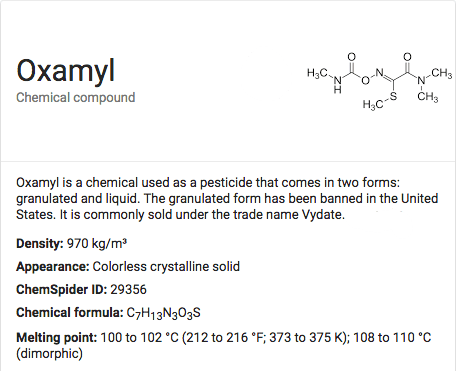About Oxamyl
Oxamyl is a highly toxic organic chemical with a slightly sulfurous odor which decomposes on distillation. The synthetic compound is used in its off-white, crystalline powder form. Oxamyl has a melting point of 108 – 110 C and a molecular weight of 219.3 g/mole.
What Types of Industrial Uses Does It Have
Oxamyl is used as a carbamate pesticide to prevent and control the attacks of pests such as insects, nematodes, and mites on crops. The chemical is used in crops, fruits, and ornamental applications since there are no residential uses for Oxamyl. The systemic pesticide is also used in plant nurseries to control pests. Tobacco growers also use the chemical on their plants to maintain an insect-free farm.
How Does Oxamyl Get into Your Drinking Water
The common cause for contaminants including Oxamyl to get into water sources are runoff and leachate from its industrial uses. In some cases, it is due to improper storage and waste management by the users. The chemical can easily get into your drinking water due to improper use and manufacture. Continuous rainfall will also help bring the contaminant into different water supplies.
What are the Health Risks Associated with Oxamyl
In higher levels, the contaminant can be dangerous to human health. contact to the synthetic pesticide can cause severe poisoning which may lead to death. Continuous exposure to the chemical can cause an individual to experience small nervous system effects. In smaller amounts, a person may experience skin and eye irritation. The chemical may also trigger vomiting, nausea, diarrhea, and abdominal pain. If exposure to the said pesticide continues, the individual may experience a headache, muscle twitching, chest tightness, convulsions, coma, and death.
What is the EPA’s Standards for Oxamyl in Drinking Water
The MCLG for the contaminant is 0.2 mg/L or 200 ppb. Levels higher than the set standard of EPA may cause serious health problems to the exposed individual. If you think your water supply contains Oxamyl or other chemicals, you must conduct a complete water test to check your water quality.
What Treatment is Recommended for Removing the Contaminant from Your Drinking Water
The best way to treat your drinking water is with granular activated carbon (GAC). If you rely on a private well, you can use granulated activated carbon to remove the impurity before it gets into your drinking water. Granulated activated carbon is a medium used to remove contaminants due to its effectiveness in catching the bad guys. A water filter system can help eliminate contaminants like Oxamyl from your drinking water. A multi-layered filter media can remove impurities from the feed water and separate them so they can’t get into your faucet. Since the pollutants are already in your water supply, the best way to protect your family is to make sure they get fresh and clean drinking water.
AquaOx has designed its water treatment systems to efficiently separate the impurities and floating dust from the good water. Get rid of the contaminants present in your water supply and improve the quality of your drinking water with a reliable water filter system today.
| Chemical Names: | OXAMYL; 23135-22-0; Dioxamyl; Thioxamyl; 2-Dimethylamino-1-(methylthio)glyoxal O-methylcarbamoylmonoxime; 2-(Dimethylamino)-N-(((methylamino)carbonyl)oxy)-2-oxoethanimidothioic acid methyl ester |
|---|---|
| Molecular Formula: | C7H13N3O3S |
| Molecular Weight: | 219.259 g/mol |
| InChI Key: | KZAUOCCYDRDERY-UITAMQMPSA-N |
| Safety Summary: | Laboratory Chemical Safety Summary (LCSS) |
OXAMYL is a white, crystalline solid, with slight sulfurous odor. Used as an insecticide, nematicide and acaricide on many field crops, vegetables, fruits, and ornamentals. (EPA, 1998)
Source: CAMEO Chemicals
URL: https://cameochemicals.noaa.gov/chemical/5099

-
Water Filters
AquaOx Whole House Water Filter
$3,499.00 – $4,999.00 Select options This product has multiple variants. The options may be chosen on the product pageRated 4.94 out of 5








